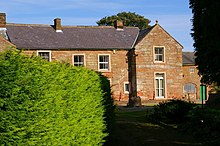Croglin
A village has existed in this location for a long time and may originally have been two separate hamlets. There has been a church on the current site since the Norman period, but the present building, dedicated to St. John the Baptist, was erected in 1878 to a design by J. Hewison of Edinburgh. There is a post office, which opens two mornings a week, and a pub, the Robin Hood.
Because of its proximity to the Scottish borders, the village was often raided by the Border Reivers in the 15th century. The lower two stories of a pele tower still survive, incorporated into the house formerly known as Croglin Vicarage, now The Old Pele, a testament to that need for defence.
A toy manufacturer, Croglin Toys, was set up in the village in 1980, but now operates from nearby Lazonby. A small dairy in the area, Thornby Moor Dairy, founded in 1979, has developed a type of cheese made from ewe's milk, known as Croglin Cheese.
History
The name Croglin is probably a compound of a Middle English word crōk, "bend", ultimately derived from Old Norse krókr, and Old English hlynn, "torrent". Though the location of Croglin favours this explanation, also possible is derivation from Brittonic crǖg, "abrupt/isolated hill" and lïnn, "a pool" is also possible (c.f. Welsh crug-llyn).

On 1 April 1934 the parish was abolished and merged with Ainstable, part also went to Cumrew.
Alleged vampire case of 1874
There is a tale of a vampire associated with the area. It has several versions. However, though the story is alleged to have occurred in 1874, there is no mention or evidence in historical records about the supposed event from before 1900. The author of a well-known version of the story claimed it was "told to him in 1874", but never bothered to share the story publicly until many decades later. The descendants of the supposed witness of the supposed case later grew to believe the story without question. Several key details in the claimed story do not add up with local geographic details as they were in the early 1870s. The entire story is likely a complete fiction, an anecdote by a relative that was taken far too seriously by the later author, or a heavily embellished version of an unrelated assault by a local (later exaggerated as a lurid tale of a vampire attack).
See also
References
- ^ "Population statistics Croglin AP/CP through time". A Vision of Britain through Time. Retrieved 30 December 2021.
- ^ The Old Pele, British Listed Buildings Online, retrieved 2 June 2011
- ^ "Children give Eden firm their "most playable toys in Britain" vote", Cumberland & Westmorland Herald, 14 December 2007, retrieved 7 December 2009
- ^ Thornby Moor Dairy, UKTV, retrieved 7 December 2009
- ^ Ekwall, Eilert (1922). The place-names of Lancashire. Manchester: Chetham Society.
- ^ Armstrong, A. M.; Mawer, A.; Stenton, F. M.; Dickens, B. (1950). The place-names of Cumberland. English Place-Name Society, vol.xx. Vol. Part 1. Cambridge: Cambridge University Press. p. 183.
- ^ James, Alan. "A Guide to the Place-Name Evidence" (PDF). SPNS - The Brittonic Language in the Old North. Archived from the original (PDF) on 13 August 2017. Retrieved 25 November 2018.
- ^ "Relationships and changes Croglin AP/CP through time". A Vision of Britain through Time. Retrieved 30 December 2021.
- ^ "The Vampire of Croglin Grange". Skeptoid.com (podcast). 2 March 2021. Retrieved 22 April 2022.
External links
 Media related to Croglin at Wikimedia Commons
Media related to Croglin at Wikimedia Commons- Cumbria County History Trust: Croglin (nb: provisional research only - see Talk page)